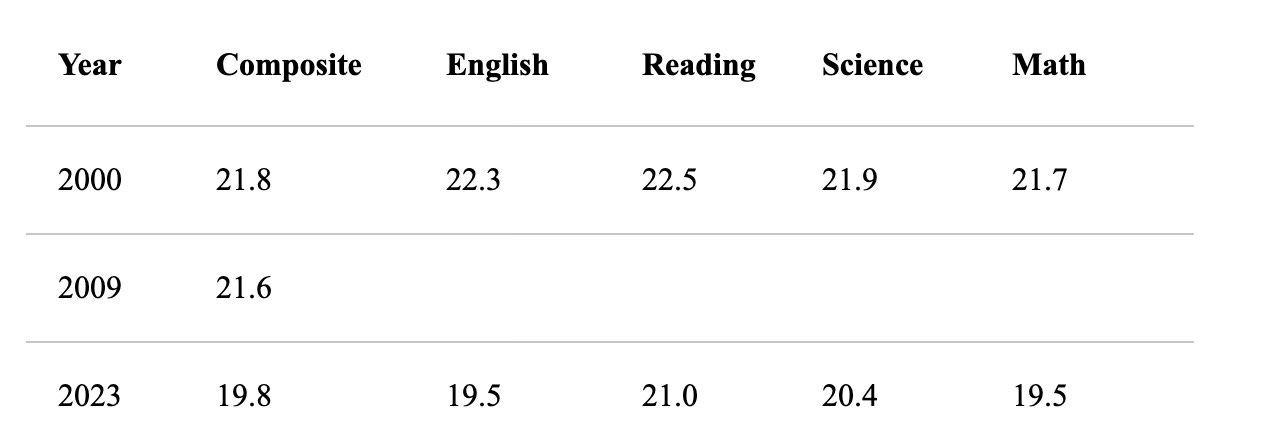Is DESE Helping Missouri Students?
The Missouri Department of Elementary and Secondary Education (DESE) has seen a significant increase in its budget over the past two decades. However, this increase in funding does not seem to correlate with an improvement in student performance. This raises the question: Is DESE effectively using its resources to benefit Missouri students?
The Numbers
In 2000, DESE had a budget of $3.1 billion.1 Fast forward to 2023, and the budget has ballooned by over 120% to $10.3 billion.2 This money is used for a variety of purposes, including curriculum development, facility management, and teacher training programs.
However, despite this increase in funding, key indicators of student performance have either declined or remained stagnant. For instance, average ACT scores, which are often used as a predictor of college readiness, have actually fallen slightly among Missouri students during this period. In 2010, the Missouri Learning Standards were introduced. While not called Common Core, the Missouri Learning Standards are indistinguishable. Scores have steadily declined in Missouri since their adoption.
Here’s a comparison of ACT scores from 2000 and 2023:3
The National Assessment of Educational Progress (NAEP), also known as the Nation’s Report Card, has shown little significant progress in math proficiency scores. In 2000, the average score for Missouri 4th graders was 228, which increased to 232 in 2022. However, the percentage of students who performed at or above the NAEP Proficient level was 34% in 2022. For 8th graders, the average score was 271 in 2000, which was not significantly different from the average score of 272 in 2022. The proficiency rate for these students was 24% in 2022.4 5
While high school graduation rates have increased from 2000 to 2023, the college enrollment rates of Missouri public high school graduates within one year of graduation have declined from 63% in 2000 to 55% in 2020.
The student population has gradually increased, DESE staff and budget have exploded. When DESE was founded, it had six employees. DESE now has 1800 employees and half are federal employees. Federal money is used for those employees. In the state of Missouri, we have 114 Counties and 519 School Districts which is 3 DESE employees per district. The student population over the last 20 years has only increased by 1.89% in Missouri.
The total increase in enrollment from 2000 to 2023 is 17,256 students, which is a 1.89% increase over the 2000 enrollment.6
The Concerns
These numbers reveal a disconnect between DESE’s growth in scope and expenses versus student outcomes. Despite the significant increase in DESE’s budget over the past 20+ years, there has been no meaningful progress in learning, skills, and preparation for higher academics and future careers.
Education reform advocates argue simply increasing funding without addressing how the money is spent lacks accountability. There is too much bureaucracy and not enough flexibility for custom approaches at the classroom level. Solutions proposed by advocates include diminishing DESE or even eliminating DESE. Other solutions include school choice without strings attached or giving School Boards more autonomy to decide the future of their students. As it is, School Boards must get DESE approval for federal funds which means they rubber stamp any DESE ideas or policies to receive these funds. When the School Board requests money through DESE, DESE is allowed to keep a percentage acting like a low-level drug dealer between the districts and the federal government.
Furthermore, concerns have been raised about the financial management of DESE. Over the last four years, DESE has carried an unfunded balance of $1.2 billion, which is counted as revenue despite not being in their possession. The budgeting process, which involves the House, Senate, and Governor’s approval, appears to be inflated with federal money, forcing the state to fund an extra $300 million each year. This has resulted in a total budget of $48 billion, with $10.3 billion allocated for DESE.
DESE in Missouri and their counterpart departments across the nation have created policies which has seen an 88% nationwide increase in administrative staff over the last 20 years, despite only an 8% nationwide increase in the student and teacher populations. The administration of education hasn’t improved student education. If we do not act, DESE will continue to grow fatter while our student’s learning grows leaner.
Conclusion
The data suggests that it may be time to take a closer look at DESE’s spending priorities and their effectiveness in furthering student achievement. The results so far raise more questions than answers. Is the increased funding being used effectively to improve student outcomes, or is it simply contributing to a growing bureaucracy? Further, short of a Sunshine Request, why was it so hard to gather data about DESE or Student Scores for the ACT? Why are these large organizations hiding data that has been paid for by taxpayers? These are questions that need to be addressed as we strive to provide the best possible education for Missouri’s students.
Copyright © 2023 by David Rice










Share this post